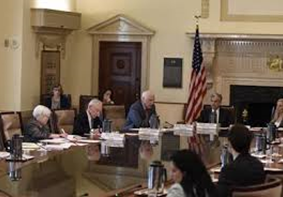I figured I would be writing about President Obama’s State of the Union speech today, but for the first time since he became president, I did not watch the speech on Tuesday night. So I can’t comment, other than to say that the reviews I read gave Mr. Obama the lowest marks of his presidency for a SOTU speech.
Today we’ll keep our attention on the 800-pound gorilla in the room – China. At the end of yesterday, the Shanghai Composite Index (SCI) closed below 3,000 for the first time since the June to late-August plunge of 43%. Since the more recent high on December 23, the SCI is down almost 20%.
The plunge in Chinese shares has affected equity markets around the world. As of yesterday’s close, the Dow was down 7.3% for the year; the S&P 500 was down 7.5%; and the Nasdaq was down 9.6%. All three markets are up sharply so far today, but it remains to be seen where China and the markets go from here.
The question is, how will these developments affect the Fed’s plan to raise short-term rates four times this year? You may recall that the Fed threatened last summer to enact lift-off at its September policy meeting. Yet when Chinese and US stocks plunged in late August, the Fed backed off and didn’t hike the Fed Funds rate until December 16.
So what happens this time? The first Fed Open Market Committee (FOMC) meeting of 2016 is on January 27-28. At year-end, most Fed watchers expected the Committee to raise the Fed Funds rate by another 0.25% at the March 17-18 meeting, followed by another 0.25% increase at the June, September and December meetings.
Yet some members of the Committee are already voicing concerns about a second rate hike due to the latest developments in China and in our own markets. Boston Fed President Eric Rosengren said yesterday that the rout in China’s stock market, weak oil and other factors are “furthering the concern that global growth has slowed significantly.”
Rosengren, who is a voting member on the FOMC this year, also said a second hike will face a “strict test” as the Fed looks for tangible evidence that US growth will be “at or above potential” and inflation is moving back up toward the Fed’s 2% target (which is not happening).
The sharp drop in China’s stock market, the latest devaluation of the yuan, a stubbornly strong dollar and a further decline in oil prices to 12-year lows present a recurrence of challenges the Fed hoped it had left behind last year.
On Monday, Atlanta Fed President Dennis Lockhart said he did not think there would be enough new data to make a decision on a second hike “until at least April,” in part because of China’s effect on US equity markets.
Robert Kaplan, the Dallas Fed’s new President, also cautioned that four interest-rate hikes are “not baked into the cake” given global stock market volatility set off by fears over a cooling Chinese economy. “This is an unusual start to the year, obviously,” Kaplan said on Monday.
While Kaplan thought there might be enough economic data by March to decide whether to raise rates again, he added: “There’s no substitute for [more] time in assessing economic data as it unfolds.”
Lockhart said he wanted “hard evidence” on a rise in inflation before the second rate hike. He’s not going to get it. Tomorrow the Labor Department is expected to announce that the Producer Price Index (wholesale prices) actually fell in December. The PPI fell 1.1% in the 12 months ended November. Another decrease tomorrow will only make that number worse.
While the Fed tries not to overreact to short-term temporary fluctuations in financial markets, the Committee should take seriously the latest developments in China, Rosengren cautioned. “These downside risks reflect continued headwinds from weakness within countries that represent many of our major trading partners and only limited data to support the projected path of inflation to target,” he said.
Chicago Fed President Charles Evans said last Thursday that it might be “mid-year” before the Fed would be able to accurately gauge if inflation was moving up. That’s a clear signal that some on the Committee do not want four rate hikes this year.
These Fed officials don’t make such statements lightly. What they don’t say is that they may be worried about deflation. If so, there may be no rate hikes this year. Stay tuned.



